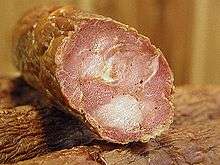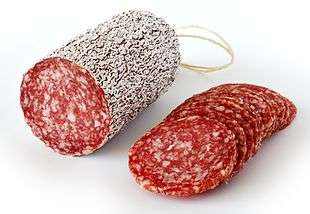Andouille
Andouille (US: /ænˈduːi/ ann-DOO-ee; French: [ɑ̃duj]; from Vulgar Latin verb inducere, meaning "to lead in") is a smoked sausage made using pork, originating in France.
 Creole andouille | |
| Course | Sausage |
|---|---|
| Place of origin | France |
| Main ingredients | Pork, garlic, pepper, onions, wine, pork chitterlings, tripe |

France
In France, particularly Brittany,[1] the traditional ingredients of andouille are primarily pig chitterlings, tripe, onions, wine, and seasoning. It is generally grey and has a distinctive odor. Also, a similar sausage is available called andouillette, literally "little andouille". Some varieties use the pig's entire gastrointestinal system. Various French region have their own recipes such as: "l’andouille de Guémené", "de Vire", "de Cambrai"," d’Aire-sur-la-Lys", "de Revin", "de Jargeau" or "de Bretagne".[2]
Italy
'Nduja, a spreadable pork salami from Calabria probably originates as a variation of andouille, originally introduced to Italy in the 13th century by the Angevins.[3]
United States
In the US, the sausage is most often associated with Louisiana Cajun cuisine, where it is a coarse-grained smoked sausage made using pork, garlic, pepper, onions, wine, and seasonings. The pork used is most of the intestine. Once the casing is stuffed, the sausage is smoked again (double smoked).[4] Nicknamed "The Andouille Capital of the World," the town of LaPlace, Louisiana, on the Mississippi River, is especially noted for its Creole andouille.[5]
The country Cajuns west of Lafayette, Louisiana, made andouille similar to the French. They seasoned the pig intestines with salt and cayenne pepper, soaked them in a water and vinegar bath overnight, and then rinsed them well before stuffing them one into another lengthwise. They cut and tied them into long links with string and hung them with the sausage in the smoke house. They were not twisted into links because they were too dense. When a link is cut, the concentric rings of the intestines can be seen. They never called it “andouille sausage”, just “andouille”; i.e., sausage and andouille are two different things to these Cajuns.[6]
Though somewhat similar, andouille is not to be confused with "hot links" or similar finely ground, high-fat, heavily peppered sausages.
See also
References
- "Produits alimentaires | Produit en Bretagne". www.produitenbretagne.bzh.
- "L'andouille". leporc.com (in French). Retrieved 2020-04-08.
- "What Is Nduja and Why Is It Suddenly on Every Menu?". Bloomberg. 15 May 2019. Retrieved 16 May 2019.
- "Andouille sausage (Gastronomy) – Definition" (various), MiMi.hu, 2006, webpage: Hu-Andou.
- "Dining & Bars". NOLA.com. Retrieved 2014-01-13.
- "Andouille". Louisiana's River Parishes. Retrieved 2020-06-26.
